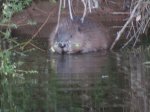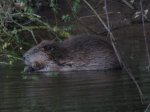Limited as I've been with getting out I've been monitoring the preparation of the local beavers for winter. I noticed their activity a few years ago and had heard they were well established on the Tay but I'm based quite far up a tributary to the Tay, the river Earn, and they are undeniably here. I bought a cheap wildlife cam and after a few failed attempts managed to gain some footage.
Since then I've occasionally gone down to see their handiwork. I was worried at one stage as they didn't seem to be making that much impact but they're back with a vengence.
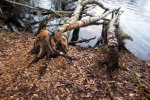
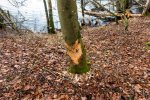
Their handiwork is something to behold and their speedy progress through trees young and old is very impressive. My understanding is that the larger trees are brought down to process the cellulose underneath the bark where they lie. I've noted that they have brought down smaller trees and removed them entirely. I don't think they'll be in a lodge, it's noted that they can live in a riverbank so I guess the smaller trees are taken away as food to be used later. Most of the trees have fallen and been stripped of their bark leaving only the bottom of the bark in place. Obviously too difficult for the beaver to remove. It does however provide ample birch bark for fire starting and in large A4 sized sheets. I still find it incredible the amount of damage caused to the trees purely by teeth. I know they're not carnivores but imagine the damage they could do with their teeth to another animal if they set their mind to it if they can do this to a mature established tree.
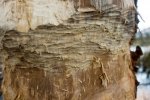
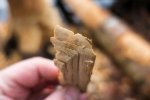
My aim for Christmas holidays is to do a slightly more detailed observation of the area to see where the beavers are most active. Then I plan to build a hide of some sort and see how active they have been. I'd like to get my drone up but there is geese, swans and ducks in the area and I wouldn't hold out much hope for my drone if it came up against any of them. I will also deploy the the wildlife camera to see what I can catch at night. I would love to get a cast of a pawprint but the ground around the fallen trees just isn't suitable.
More pics over on my blog
And just for fun
Since then I've occasionally gone down to see their handiwork. I was worried at one stage as they didn't seem to be making that much impact but they're back with a vengence.


Their handiwork is something to behold and their speedy progress through trees young and old is very impressive. My understanding is that the larger trees are brought down to process the cellulose underneath the bark where they lie. I've noted that they have brought down smaller trees and removed them entirely. I don't think they'll be in a lodge, it's noted that they can live in a riverbank so I guess the smaller trees are taken away as food to be used later. Most of the trees have fallen and been stripped of their bark leaving only the bottom of the bark in place. Obviously too difficult for the beaver to remove. It does however provide ample birch bark for fire starting and in large A4 sized sheets. I still find it incredible the amount of damage caused to the trees purely by teeth. I know they're not carnivores but imagine the damage they could do with their teeth to another animal if they set their mind to it if they can do this to a mature established tree.


My aim for Christmas holidays is to do a slightly more detailed observation of the area to see where the beavers are most active. Then I plan to build a hide of some sort and see how active they have been. I'd like to get my drone up but there is geese, swans and ducks in the area and I wouldn't hold out much hope for my drone if it came up against any of them. I will also deploy the the wildlife camera to see what I can catch at night. I would love to get a cast of a pawprint but the ground around the fallen trees just isn't suitable.
More pics over on my blog
And just for fun

